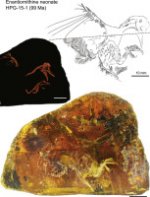Fred Ruhe
Well-known member

Lida Xing; Jingmai K. O'Connor; Ryan C. McKellar; Luis M. Chiappe; Kuowei Tseng; Gang Li; Ming Bai, 2017
A mid-Cretaceous enantiornithine (Aves) hatchling preserved in Burmese amber with unusual plumage
Gondwana Research. in press. doi:10.1016/j.gr.2017.06.001
http://www.sciencedirect.com/science/article/pii/S1342937X17300527
Abstract:
Highlights
• We report on the most complete bird preserved encased in Amber uncovered to date, including most of the skull and neck, a partial wing and hindlimb, and soft tissue of the tail, the morphologies of which refer this specimen to the Enantiornithes.
• The proportions of the bird and morphology of the plumage indicate a very young individual, adding the mounting data that the Enantiornithes were highly precocial; however, the scarcity of body feathers represents a distinct departure from living precocial birds.
• The plumage includes filamentous body feathers that resemble proto-feathers, scutellae with distal bristle-structures, mature remiges, and erupting ornamental rectrices, revealing an unexpected diversity of primitive and derived feather morphotypes present in the plumage of early birds.
Abstract:
Burmese amber has recently provided some detailed glimpses of plumage, soft tissues, and osteology of juvenile enantiornithine birds, but these insights have been restricted to isolated wing apices. Here we describe nearly half of a hatchling individual, based on osteological and soft tissue data obtained from the skull, neck, feet, and wing, and identified as a member of the extinct avian clade Enantiornithes. Preserved soft tissue provides the unique opportunity to observe the external opening of the ear, the eyelid, and fine details of tarsal scutellation. The new amber specimen yields the most complete view of hatchling plumage and integument yet to be recovered from the Cretaceous, including details of pterylosis, feather microstructure, and pigmentation patterns. The hatchling was encapsulated during the earliest stages of its feather production, providing a point for comparisons to other forms of body fossils, as well as isolated feathers found in Cretaceous ambers. The plumage preserves an unusual combination of precocial and altricial features unlike any living hatchling bird, having functional remiges combined with sparse body feathers. Unusual feather morphotypes on the legs, feet, and tail suggest that first generation feathers in the Enantiornithes may have been much more like contour feathers than the natal down observed in many modern birds. However, these regions also preserve filamentous feathers that appear comparable to the protofeathers observed in more primitive theropods. Overall, the new specimen brings a new level of detail to our understanding of the anatomy of the juvenile stages of the most species-rich clade of pre-modern birds and contributes to mounting data that enantiornithine development drastically differed from that of Neornithes.
Enjoy,
Fred
A picture of the Enantiornithes species
A mid-Cretaceous enantiornithine (Aves) hatchling preserved in Burmese amber with unusual plumage
Gondwana Research. in press. doi:10.1016/j.gr.2017.06.001
http://www.sciencedirect.com/science/article/pii/S1342937X17300527
Abstract:
Highlights
• We report on the most complete bird preserved encased in Amber uncovered to date, including most of the skull and neck, a partial wing and hindlimb, and soft tissue of the tail, the morphologies of which refer this specimen to the Enantiornithes.
• The proportions of the bird and morphology of the plumage indicate a very young individual, adding the mounting data that the Enantiornithes were highly precocial; however, the scarcity of body feathers represents a distinct departure from living precocial birds.
• The plumage includes filamentous body feathers that resemble proto-feathers, scutellae with distal bristle-structures, mature remiges, and erupting ornamental rectrices, revealing an unexpected diversity of primitive and derived feather morphotypes present in the plumage of early birds.
Abstract:
Burmese amber has recently provided some detailed glimpses of plumage, soft tissues, and osteology of juvenile enantiornithine birds, but these insights have been restricted to isolated wing apices. Here we describe nearly half of a hatchling individual, based on osteological and soft tissue data obtained from the skull, neck, feet, and wing, and identified as a member of the extinct avian clade Enantiornithes. Preserved soft tissue provides the unique opportunity to observe the external opening of the ear, the eyelid, and fine details of tarsal scutellation. The new amber specimen yields the most complete view of hatchling plumage and integument yet to be recovered from the Cretaceous, including details of pterylosis, feather microstructure, and pigmentation patterns. The hatchling was encapsulated during the earliest stages of its feather production, providing a point for comparisons to other forms of body fossils, as well as isolated feathers found in Cretaceous ambers. The plumage preserves an unusual combination of precocial and altricial features unlike any living hatchling bird, having functional remiges combined with sparse body feathers. Unusual feather morphotypes on the legs, feet, and tail suggest that first generation feathers in the Enantiornithes may have been much more like contour feathers than the natal down observed in many modern birds. However, these regions also preserve filamentous feathers that appear comparable to the protofeathers observed in more primitive theropods. Overall, the new specimen brings a new level of detail to our understanding of the anatomy of the juvenile stages of the most species-rich clade of pre-modern birds and contributes to mounting data that enantiornithine development drastically differed from that of Neornithes.
Enjoy,
Fred
A picture of the Enantiornithes species




